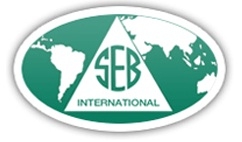
|
|
| home | contact | team t&d | group websites | markets | exports | blog |
 |
|
Cable Rollers For Straight Horizontal Cable Runs In Underground Cable Trenches
By Chris Dodds on 11th November, 2013

LV-HV power cables should be supported on straight cable rollers which have no sharp edges to damage cable sheathing under tension when being pulled into the cable trench.
The cable roller must be placed directly into the open cable trench to prevent the LV-HV power cable from dragging on the bottom of the trench.
Pictured: SEB Trench Cable Rollers

Cable roller spacing is dependent upon cable type and cable pulling tension along the route. Prior to the cable being laid onto the straight cable roller it is advised to use leading cable rollers to support the actual cable over the entire cable drum width.
During preparation of the cable trench, the trench bottom should be as level as possible and any gradient changes should be made as gradual as site conditions permit.
The cable trench bottom must be free of stones and the edges of the trench shall be cleared of any stones, tools or objects which may fall into the trench and damage the cable.
Further Reading:
- Cable Laying & Pulling - Installing LV-HV Cable In Duct (Part 1 of 2)
- Cable Laying & Pulling - Installing LV-HV Cable In Trench (Part 2 of 2)
Invitation
Thorne & Derrick are inviting you to join LinkedIn’s fastest growing Discussion Group : Low & High Voltage Power, Cabling, Jointing, & Hazardous Area Electricals (LV-HV).
Discussion subjects include cable installations, cable jointing, electrical substation, overhead line and electrical construction at LV, 11kV, 33kV and EHV.
Network, engage and promote your profile, company or products with over 10,000 influencers.
 |
Category: Cable Laying & Cable Pulling
Sort by Category:
- #ThrowBackThursday
- 3M Scotch Tapes
- ABB Power Products
- Business
- Cable Accessories
- Cable Cleats & Cable Ties
- Cable Containment LV HV
- Cable Crimping & Cutting Tools
- Cable Jointer Training Courses
- Cable Jointing - PhotoBlog
- Cable Labelling & Marking
- Cable Laying & Cable Pulling
- Cable Transits & Duct Sealing
- Company Updates
- Earthing & Lightning Protection
- Electrical Equipment HV
- Electrical Equipment LV
- Electrical Safety & Arc Flash
- Exports
- Flexible Conduit Cable Management
- Hazardous Area Electricals & Lighting
- HV Cable Jointing & Terminating
- LV Cable Jointing & Terminating
- Nexans Euromold Cable Accessories
- Plugs & Sockets
- Power Distribution & Feeder Pillars
- Prysmian FP Cables
- PV Solar Farms
- Rail
- T&D History Blog
- Terms & Conditions of Sale & Purchase
Tweets by @ThorneanDerrick






























